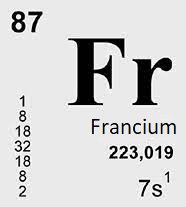Francium is an extremely rare and unstable metal with the atomic number 87 and symbol Fr. Because it is so rare and unstable, only a very small amount of information is known about its properties. Alkali metal.
Physical properties of francium
Due to its rarity and instability, very few physical properties of francium have been measured experimentally. However, some properties have been predicted based on its position in the periodic table and on theoretical calculations. Here are some of the predicted physical properties of francium:
- Appearance: Francium is expected to have a silvery-white metallic appearance, similar to other alkali metals.
- Density: Francium is expected to have a low density, lower than that of most other metals.
- Melting and boiling points: The melting and boiling points of francium are expected to be very low compared to other metals, due to its low atomic mass and large atomic size.
- Atomic radius: Francium has the largest atomic radius of all the elements, due to its low atomic number and the shielding effect of its many electron shells.
- Electronegativity: Francium is expected to have the lowest electronegativity of all the elements, due to its large atomic size and the weak attraction between its nucleus and electrons.
Overall, very little experimental data exists on the physical properties of francium, and most of what is known about it is based on theoretical predictions. Francium’s extreme rarity and instability make it difficult to study in detail.
Chemical properties of francium
Francium is a highly reactive metal, similar to other alkali metals in the periodic table. However, due to its rarity and instability, very little experimental data exists on its chemical properties. Here are some of the predicted chemical properties of francium:
- Reactivity: Francium is predicted to be highly reactive, especially with water and halogens. It is expected to react violently with water, producing hydrogen gas and francium hydroxide.
- Oxidation states: Like other alkali metals, francium is expected to have a +1 oxidation state, meaning that it tends to lose one electron when it forms a chemical bond with another element.
- Electronegativity: Francium is predicted to have a very low electronegativity, which means that it is not very good at attracting electrons to itself.
- Compounds: Very few compounds of francium have been synthesized due to its rarity and instability. However, it is predicted that francium would form compounds with halogens and other nonmetals.
- Isotopes: Francium has 34 known isotopes, all of which are unstable and highly radioactive. The most stable isotope, francium-223, has a half-life of just 22 minutes.
Overall, francium’s chemical properties are expected to be similar to those of other alkali metals, but its extreme rarity and instability make it difficult to study in detail.
Use of francium
Due to its extreme rarity and high radioactivity, francium has no practical applications. However, it has some scientific and research applications. For example:
- Fundamental research: Francium is used in fundamental research in nuclear physics and atomic physics. It is particularly interesting for researchers studying nuclear structure and properties.
- Medical research: Some isotopes of francium have been used in medical research to study the properties of cancer cells and to develop new treatments for cancer.
- Atomic clocks: Francium has been used in experiments to improve the accuracy of atomic clocks. It is one of the few elements that can be used to measure time with high precision.
- Radiography: Some isotopes of francium have been used in radiography to study the structure of materials. However, this use is limited due to the extreme rarity and high cost of francium.
Overall, francium’s practical applications are limited due to its extreme rarity, high radioactivity, and short half-life of its isotopes. However, it has some scientific and research applications, particularly in the fields of nuclear physics, atomic physics, and medical research.
